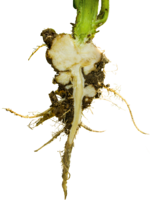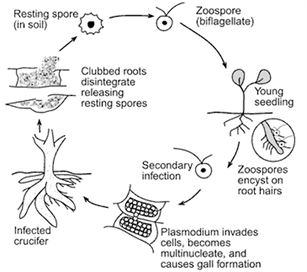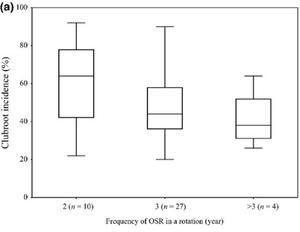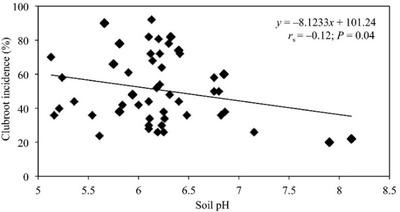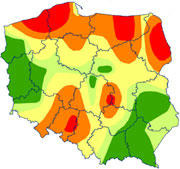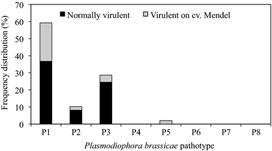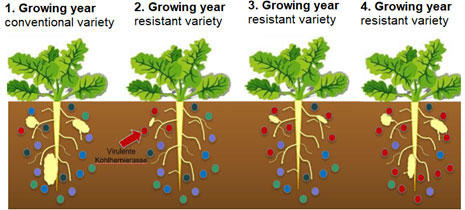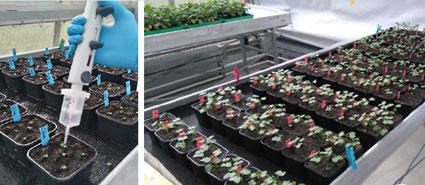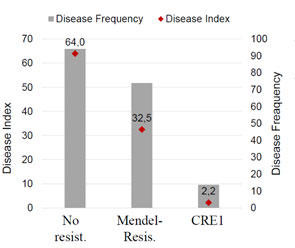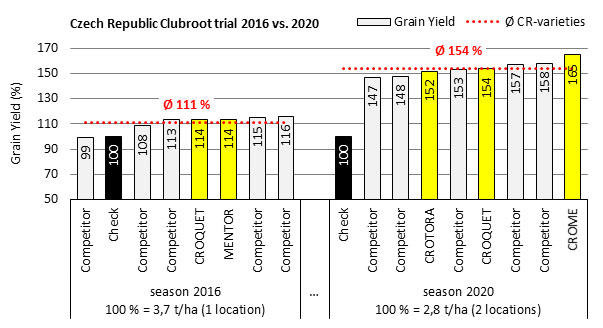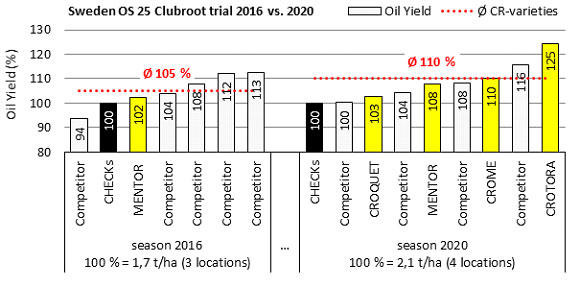The soil-borne, obligate biotrophic pathogen, Plasmodiophora brassicae W., is the causal agent of clubroot disease on oilseed rape and many other Brassicaceae.
Upon infection P. brassicae induces gall formation on roots and subsequently wilting of above ground biomass and thus can heavily limit further plant development and seed yield production. If the infestation is very severe, this can even lead to complete plant failure. In addition, the galls harbor millions of new resting spores that can persist in the soil for up to 20 years, pose an infectious threat to oilseed rape. |
| When a cruciferous host plant (many weeds besides rapeseed) is grown, the resting spores germinate and release flagellated zoospores that move freely in the soil water. When there is sufficient moisture in the soil, the zoospores penetrate the root hairs of the host plant and form a plasmodium, from which secondary zoospores are again released into the soil. Only when these zoospores infect the host plant a second time the typical galls form on the roots. The durable resisting spores are now formed in secondary plasmodia and are released into the soil when the root galls rot after harvesting and can survive there for up to 20 years until a new host plant is grown (Figure 1). | |
| Figure 1: Life cycle of P. brassicae; Source: Ohio State University (www.canolacouncil.org |
The more frequent rapeseed is grown as a host plant for clubroot, the more the inoculum can build up in the soil. During the last years scientific studies have shown that next to intensive rapeseed cultivation in tight crop rotations, high precipitation (soil moisture > 60%) and low pH in soil (pH < 7) are further factors that favor the infection with clubroot pathogen (Figure 2; Figure 3).
| Figure 2: Effect of frequency of OSR in a 2–5 year rotation on clubroot incidence (%) in 49 Plasmodiophora brassicae‐infested fields located in different federal states in Germany. [1] | Figure 3: Correlation between soil pH and clubroot incidence (%) from 49 Plasmodiophora brassicae‐infested fields located in different federal states in Germany.1 |
In recent years, clubroot has become a serious problem in several important rapeseed-growing regions in Europe. The most heavily infested areas are located around the Baltic Sea with large parts in the North of Germany, but also large areas in the North of Poland (Figure 4), the Baltics and the northern part of the United Kingdom. In addition, we are also seeing an incipient spread with lower infestation levels in almost all other important European growing regions.
| Figure 4: The recommendations for the cultivation of oilseed rape and vegetable brassicas based on the quantification of Plasmodiophora brassicae in Polish agricultural soils.[2] |
Based on extensive analysis during the last years, it could be confirmed, that we have different races of clubroot in the fields. These differ in their virulence to the host plants and are divided into different pathotypes (P1 to 8) with pathotype 1 and 3 being the most widespread in Germany for example (Figure 5). | |
Figure 5: Frequency distribution of Plasmodiophora brassicae pathotypes according to Somé et al. (1996) from 49 field populations in different German federal states.1 |
In 2001, the first Clubroot-resistant hybrid was launched in the European rapeseed market. This was the variety MENDEL, which resulted from successful research and breeding by RAPOOL. Already in 1987, the basis for the MENDEL resistance was laid with the crossing of kale (B. oleracea) and stubble turnip (B. rapa). By further crossing this synthetic rapeseed with the variety FALCON in 1989 and subsequent dihaploidization and conventional selection, the resistance was finally fixed in our winter oilseed rape genetics. After a total of 12 years of continuous breeding and research under greenhouse and field condition, the world's first Clubroot-resistant variety MENDEL was applied for registration in Germany and the United Kingdom in 1999 and finally approved in 2001.
However, it was clear from the beginning that the MENDEL-resistance would not protect against all pathotypes in the environment and thus was considered a race-specific resistance. It was unclear to what extent the resistance would fend off clubroot disease if regularly grown on clubroot infested fields. Today, we know that the MENDEL-resistance still provides an effective protection on many field sites but due to the popularity of oilseed rape in crop rotation in the past two decades more sites are found, where MENDEL-resistant plants in the field show the typical tumorous root growth (Figure 8). However, the frequency of MENDEL-virulent pathotypes is largely determined by the analyzed samples. Since usually only samples from infested sites are analyzed, this problem can easily be overestimated.
The effect behind the MENDEL-virulent pathotypes is called race shift: The cultivation of Clubroot resistant varieties allows only those Clubroot races to multiply in the soil against which the race-specific resistance is not effective, resulting in a shift of Clubroot races (Figure 6).
The earlier and the more frequent a resistant variety is grown, the earlier a race shift can be expected.
Figure 6: Shifting of Clubroot Races in the Soil (red dots = virulent clubroot variety). Source: RAPOOL 2016; D. Bornhöft
An adequate resistance management is therefore very important, starting with the cultivation management. A resistant variety should be only grown if infections in the field are confirmed to prolong the efficacy of the resistance. If a MENDEL-resistant variety is infected once, OSR cultivation at this field should be avoided until varieties with broader resistance are available.
However, clubroot is very immobile compared to other pathogens because it is only in the soil and not spread by wind. Therefore, we can typically see specific zones in the field with plants of reduced growth. But there are some preventive strategies that can be used today to limit the infestation and spread (no chemical control possible) in the farm:
- Avoid moving of contaminated soil (with machines, wheels, shoes …).
- Control of cruciferous weeds and volunteer rapeseed (field sanitation).
- Keep growing breaks for rapeseed and pay attention to an adequate crop rotation. Higher OSR frequency increases clubroot incidence (Figure 2)
- Prefer later sowing dates, as early sowing dates have a higher risk of infection due to higher soil temperatures. Below 15°C the risk of infection decreases significantly[3].
- Grow a clubroot resistant variety, only when clubroot is in the soil (resistance management).
- Increase the soil pH by liming. (Figure 3)
- Avoid waterlogging and maintain drainage.
Due to the decreasing effectiveness of the MENDEL-resistance on some fields and the increasing spread respectively damage by clubroot disease, our research team continuously worked on the development of new resistance sources. Research on improved resistance starts with infection experiments in the greenhouse with various clubroot isolates. Seedlings are infected with a standardized spore suspension and are cultivated under infectious conditions until symptoms can be scored (Figure 7). These trials demonstrated an enhanced resistance phenotype compared to the former MENDEL-resistance, called CRE1. The new CRE1-resistance is a native trait, which was introduced from Brassica rapa into oilseed rape. Although being also race-specific, CRE1 protects against races avirulent on MENDEL plus substantially more races that are virulent on MENDEL (Figure 8). Thus, CRE1 is an extension of the MENDEL-resistance, potentially allowing to grow new rapeseed varieties carrying CRE1 even at sites where clubroot pathotypes are able to infect the original MENDEL-resistance.
Figure 7: Infection of seedlings in the greenhouse. Source: NPZ Innovation GmbH
| RAPOOL will be the first breeder offering the enhanced Clubroot resistance in winter oilseed rape, which will provide new solutions to the European rapeseed farmers affected by Clubroot. New candidates with improved CRE1-resistence are in the registration process right now. In the next couple of years, we can expect the first registrations.
Figure 8: CRE1 resistance in a field with breakdown of Mendel resistance, autumn 2018 Pratjau, Germany; Source: Glameyer/Grohall NPZ |
Next to the development of new clubroot resistances like CRE1 RAPOOL offers an attractive portfolio of valuable hybrids for the rapeseed farmers. While in the past clubroot varieties like MENTOR gave the chance to grow rapeseed successfully on infected soils, farmers had to accept a clear yield gap in comparison with other classical (susceptible) varieties, grown in the same region under similar conditions. Today, the situation has changed, based on breeding progress we can observe that several new hybrids like CROME or CROTORA are able to close the yield gap. Official trials from SPZO in Czech Republic on infected soils underline clear the value of such resistances for farmers in clubroot areas. While hybrids like MENTOR were delivering just a small yield gain in 2016 (Figure 9), we can recognize the significant advantage of new Clubroot hybrids like CROME, who is leading the official trials in 2020 with more than 60 % higher yields than the susceptible check.
CROME convinced with a powerful development in autumn, quick regrowth after winter and a mid-early flowering. The variety package also includes good plant health, respectively lodging resistance, and a mid-early ripening. Especially the powerful establishment before winter is the base in “clubroot years” with usually wet conditions like in autumn 2019 in Czech Republic. A quick root growth enables biomass developments, which are necessary especially under continental climate conditions with early spring or summer drought.
A further attractive clubroot hybrid, CROTORA, is based on one of our most successful hybrids in the last years: ATORA. Especially under more tough conditions like in Sweden, we require a reliable winter hardiness and high tolerance against late frost appearance. CROTORA convinced in the official clubroot trials in Sweden 2020 (OS7-25, Figure 10) with 125 % rel. yield. The clear difference to further tested varieties is based next to strong autumn development and good winter hardiness also on the robust plant health with a higher tolerance against Phoma lingam or Verticillium.
Fortunately, we see in the variety performances of our new commercialized clubroot varieties a clear yield progress. While the tested group of clubroot varieties in Sweden 2016 reached just a plus of 5 % in comparison with the susceptible checks, the current portfolio was able to reach 110 % in 2020, despite higher performing checks.
Figure 9: Yield advantage of CR-varieties under stronger infestation conditions clearly visible in the Czech Republic. Yields of CR varieties in 2016 and 2020 compared to 1 conventional (susceptible) variety (check) in both years. Source: SPZO Czech Republic 2016 and 2020.
|
| Figure 10: Yield advantage of CR-varieties under stronger infestation conditions clearly visible in Sweden. Yields of CR varieties in 2016 and 2020 compared to 4 conventional (susceptible) varieties (checks) in both years. Source: Sweden Official Trials (OS7-25) 2016 and 2020. Checks 2016 = DK Exstorm, Avatar, Epure, Apanai; Checks 2020 = Atora, Mercedes, SY Harnas, DK Explicit; only CR-varieties presented. |
Summary
Clubroot has become a serious problem in several important rapeseed-growing regions in Europe. If Plasmodiophora brassicae is in the soil, it causes galls on roots of oilseed rape and other Brassicaceae, that can lead to total damage in case of heavy infestation. Since chemical control of the pathogen is not possible, it is even more important to consider some preventive measures in crop management: First, it is important to keep growing breaks for rapeseed (and other host plants) and pay attention to an adequate crop rotation, as a higher OSR frequency increases clubroot incidence. In this context it is also important to control cruciferous weeds and volunteer rapeseed! Earlier sowing dates as well as lower soil-pH values and waterlogging will increase the risk and severity of the infestation. We recommend using later sowing dates (lower soil temperature), to increase the soil pH by liming and to maintain drainage on the fields. Avoiding moving of contaminated soil is also particularly important to prevent the spread to other (uninfected) fields.
There are different pathotypes (races) of clubroot, which differ in their virulence to host plants. The cultivation of clubroot resistant varieties allows only those clubroot races to multiply in the soil against which the race-specific resistance is not effective, resulting in a long-term shift of Clubroot races. The earlier and the more frequently a resistant variety is grown, the sooner a race shift can be expected. As the classical MENDEL-resistance has partially lost its effectiveness and due to the increasing widespread and damage of Clubroot, RAPOOL continuously worked on the development of new resistances. We found a new trait, called CRE1, which protects against more races compared to the former MENDEL-resistance. With the newest generation of Clubroot-resistant varieties of RAPOOL and the general breeding progress which closes the yield gap between resistant and conventional hybrids, RAPOOL became a reliable partner for Clubroot affected farmers. Different official trials from Czech Republic or Sweden confirmed the progress in our new Clubroot varieties CROME and CROTORA. But an adequate resistance management is very important, to protect the resistance as long as possible and to prevent further race shifting.
[1] Zamani‐Noor, N. (2017). Variation in pathotypes and virulence of Plasmodiophora brassicae populations in Germany. Plant pathology, 66(2), 316-324.
[2] Czubatka-Bieńkowska, A., Kaczmarek, J., Marzec-Schmidt, K., Nieróbca, A., Czajka, A., & Jędryczka, M. (2020). Country-Wide qPCR Based Assessment of Plasmodiophora brassicae Spread in Agricultural Soils and Recommendations for the Cultivation of Brassicaceae Crops in Poland. Pathogens, 9(12), 1070.
[3] Wagner/Glameyer, NPZ (2017), Soil Temperature and Clubroot Trials Hohenlieth.


